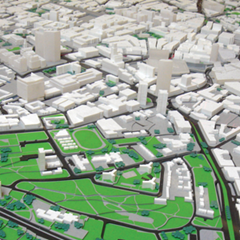Future planning
 Ireland’s natural environment should be an asset not an after-thought for planners, according to advocates of the green infrastructure concept.
Ireland’s natural environment should be an asset not an after-thought for planners, according to advocates of the green infrastructure concept.
Various shades of grey are the standard colours connected with the word infrastructure so the term ‘green infrastructure’ can seem an oxymoron. However, the term has become more familiar since it was first coined in the USA during the 1990s. It sums up the green spaces, habitats and ecosystems within a defined geographic area: everything from mountain peaks to gardens, rivers and canals in Ireland.
The concept is the subject of two research reports in 2010: ‘Creating Green Infrastructure for Ireland’ by the Sustainable Development Council (Comhar), and ‘Green Infrastructure: A quality of life issue’ by the Urban Forum and the Institute of Ecology and Environmental Management.
A territory’s species and scenery have an intrinsic non-economic value but, taken together, they also help to manage the flow of water, provide food, timber and other raw materials for the economy and influence micro-climates.
Green infrastructure differs from traditional conservation, which focuses on preserving the natural environment, and looks at how settlements and economies can grow without losing their biodiversity or damaging their quality of life.
The Netherlands is often cited as a pioneer in ‘green infrastructure planning’ although Dutch authorities were carrying this out well before the term was invented. Its population increased from 9.3 million in 1945 to 16.7 million last year, and around one-fifth of the land area is reclaimed from the sea (polders). The severe storm of February 1953 also focused planners’ attention on how to tackle severe coastal flooding and led to the extensive building of dikes and barriers around the Rhine-Meuse-Scheldt delta.
Indeed, the Urban Forum points out that ignoring the environment and building over floodplains has led to regular urban flooding in Ireland.
Comhar proposed that a typical green infrastructure plan would include the normal process planning, analysis, plan and strategy formulation, and implementation stages. Farmers would only receive subsidies for production if they participated in agri-environmental schemes.
Forest cover would be expanded, including replanting copses in fertile lowland areas and new riverside woodlands to protect surrounding areas from flooding. Ideally, these new woodlands should be grown from fully native broadleaf species.
Green infrastructure is integrated into Fingal County Council’s development plan for 2011-2017. All planning applications will be assessed for their impact on Natura 2000 sites and how they will conserve or enhance biodiversity. Major applications must include their own ‘green infrastructure plan’.
The public will be encouraged to stay away from sensitive natural reserves and visit others open spaces such as parks. The council aims to resist development that would “fragment or prejudice” Fingal’s existing green infrastructure and also seeks a “net gain” in its coverage e.g. by approving cycle paths and green roofs.
A 10-15m ‘riparian strip’ of undeveloped land will be set aside along all watercourses (except where development has already taken place), increasing to 30m on selected rivers outside urban areas. New wetland areas will be encouraged.
The Urban Forum recommends that any green infrastructure plan should clearly set out what it means by the term. Fingal also takes a loose interpretation by including historic buildings, which are manmade but do add to an area’s appearance. The expertise of landscape architects, ecologists and engineers should be considered, and data on all assets and resources must be converted into detailed maps.
A draft national landscape strategy was published for consultation between September and November last year, indicating that the Government would establish ‘green infrastructure appraisal standards’ in its final version.
Environmentalists also want the Government to reopen the National Spatial Strategy but Environment Minister Phil Hogan has said that this would only be considered on economic grounds. New development has been concentrated around Dublin since the existing strategy was published in 2002, despite its intention to distribute the population more evenly.
Photo Credit: Irum Shahid





